飞书开发学习笔记(五)-Python快速开发网页应用
飞书开发学习笔记(五)-Python快速开发网页应用
一.下载示例代码
首先进入飞书开放平台: https://open.feishu.cn/app
凭证与基础信息 页面,在 应用凭证 中获取 App ID 和 App Secret 值。
教程和示例代码位置:https://open.feishu.cn/document/home/integrating-web-apps-in-5-minutes/create-app-and-configuration
共分为四步,其中示例代码在这个位置: 示例代码
下载完毕后,整理文件夹目录:
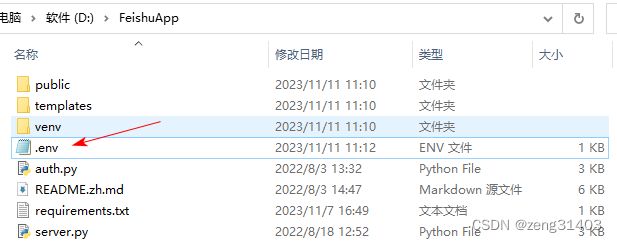
进入.env文件,修改 App ID 和 App Secret为开发者后台获取的值。
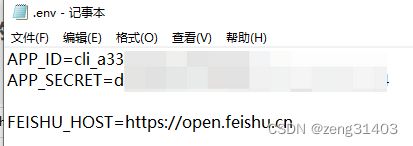
在命令行中创建虚拟环境,并启动虚拟环境:
python -m venv venv
venv\Scripts\activate
(venv) D:\FeishuApp>
二.下载示例代码
2.1 示例代码结构
示例代码结构
https://open.feishu.cn/document/home/integrating-web-apps-in-5-minutes/debug-and-release
.
├── README.zh.md ----- 说明文档
├── public
│ ├── svg ----- 前端图形文件
│ ├── index.css ----- 前端展示样式
│ ├── index.js ----- 前端交互代码
├── templates
│ ├── index.html ----- 前端用户信息展示页面
├── auth.py ----- 服务端获取jsapi_ticket等
├── server.py ----- 服务端核心业务代码
├── requirements.txt ----- 环境配置文件
└── .env ----- 全局默认配置文件,主要存储App ID和App Secret等
2.2 下载所需的环境配置
├── requirements.txt ----- 环境配置文件
requirements.txt文件中定义了所需的环境依赖,在命令行中输入命令安装依赖:
pip install -r requirements.txt
requirements.txt的内容
Flask==2.0.2
python-dotenv
requests
pycryptodome
Werkzeug<3
2.3 安装依赖后启动服务
启动server.py
(venv) D:\FeishuApp>python server.py
允许防火墙通过
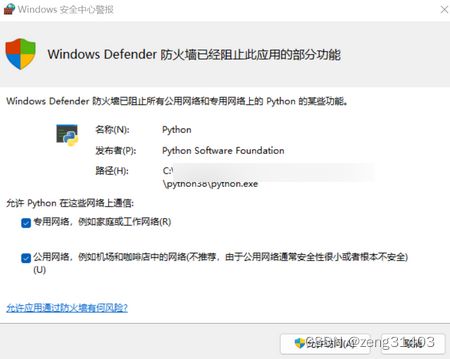

将服务器地址 http://192.168.3.22:3000/填入到浏览器中,现实结果如下:
内容为:
{
“message”: “index.html”
}
没有达到预期的效果。

看命令行的调试结果,显示状态码为500,出现了内部服务器错误
192.168.3.22 - - [12/Nov/2023 12:47:42] "GET / HTTP/1.1" 500 -
192.168.3.22 - - [12/Nov/2023 12:47:42] "GET /favicon.ico HTTP/1.1" 500 -
2.4 Python依赖的安装
发现网页运行显示500错误以后,将该目录在cmd命令行下执行,发现是requirements.txt安装不成功。
然后在cmd命令行下再执行一次
pip install -r requirements.txt
安装成功以后,再运行一次确认全部成功后,再运行server.py
(venv) D:\FeishuApp>python server.py

找到新的网页地址:http://192.168.31.244:3000/ 打开后先有提示:


显示网页打开成功
2.5 网页应用添加
在开发者后台中,添加应用能力,增加网页应用
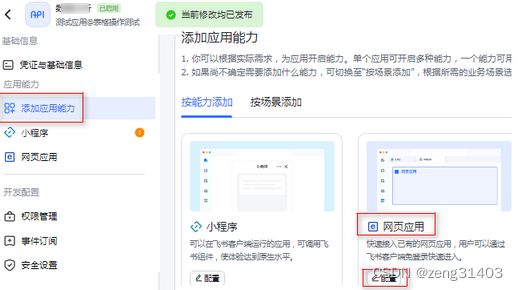
在网页应用配置中,桌面段主页和移动端主页添加上述调试主页地址
H5可信域名中添加上述调试主页地址

然后,打开并登录飞书,在工作台中可以看到增加的应用:
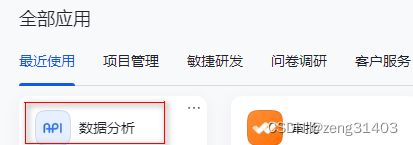
打开电脑端和手机端,都能看到这个页面:

说明网页应用示例开发成功了。
三.示例代码内容
3.1 auth.py服务端获取jsapi_ticket等
auth.py在server.py中导入,主要通过API进行鉴权,获取jsapi_ticket
authorize_tenant_access_token()利用TENANT_ACCESS_TOKEN_URI 函数,通过app_id和app_id获取tenant_access_token
get_ticket()利用JSAPI_TICKET_URI 函数,通过feishu_host和tenant_access_token获取ticket
最终,该类返回jsapi_ticket
├── auth.py ----- 服务端获取jsapi_ticket等
import requests
import logging
# const
# 开放接口 URI
TENANT_ACCESS_TOKEN_URI = "/open-apis/auth/v3/tenant_access_token/internal"
JSAPI_TICKET_URI = "/open-apis/jssdk/ticket/get"
class Auth(object):
def __init__(self, feishu_host, app_id, app_secret):
self.feishu_host = feishu_host
self.app_id = app_id
self.app_secret = app_secret
self.tenant_access_token = ""
def get_ticket(self):
# 获取jsapi_ticket,具体参考文档:https://open.feishu.cn/document/ukTMukTMukTM/uYTM5UjL2ETO14iNxkTN/h5_js_sdk/authorization
self.authorize_tenant_access_token()
url = "{}{}".format(self.feishu_host, JSAPI_TICKET_URI)
headers = {
"Authorization": "Bearer " + self.tenant_access_token,
"Content-Type": "application/json",
}
resp = requests.post(url=url, headers=headers)
Auth._check_error_response(resp)
return resp.json().get("data").get("ticket", "")
def authorize_tenant_access_token(self):
# 获取tenant_access_token,基于开放平台能力实现,具体参考文档:https://open.feishu.cn/document/ukTMukTMukTM/ukDNz4SO0MjL5QzM/auth-v3/auth/tenant_access_token_internal
url = "{}{}".format(self.feishu_host, TENANT_ACCESS_TOKEN_URI)
req_body = {"app_id": self.app_id, "app_secret": self.app_secret}
response = requests.post(url, req_body)
Auth._check_error_response(response)
self.tenant_access_token = response.json().get("tenant_access_token")
@staticmethod
def _check_error_response(resp):
# 检查响应体是否包含错误信息
if resp.status_code != 200:
raise resp.raise_for_status()
response_dict = resp.json()
code = response_dict.get("code", -1)
if code != 0:
logging.error(response_dict)
raise FeishuException(code=code, msg=response_dict.get("msg"))
class FeishuException(Exception):
# 处理并展示飞书侧返回的错误码和错误信息
def __init__(self, code=0, msg=None):
self.code = code
self.msg = msg
def __str__(self) -> str:
return "{}:{}".format(self.code, self.msg)
__repr__ = __str__
3.2 server.py服务端利用Flask建立网页
server.py服务端利用Flask建立网页
1.初始化Flask,示例为app
2.先实例化auth类,获取feishu_host, app_id, app_secret,tenant_access_token和ticket
3.定义路由get_home(),渲染"index.html",渲染后执行index.js获取前端的config参数
4.config参数中,通过ticket,随机字符串,网页地址url,以及当前时间戳组合成一个字符串
5.使用sha1加密,得到签名signature
6.index.js将鉴权所需参数返回前端
7.渲染index.html
├── server.py ----- 服务端核心业务代码
#!/usr/bin/env python
# -*- coding: UTF-8 -*-
import os
import time
import hashlib
import requests
from auth import Auth
from dotenv import load_dotenv, find_dotenv
from flask import Flask, request, jsonify, render_template
# const
# 随机字符串,用于签名生成加密使用
NONCE_STR = "13oEviLbrTo458A3NjrOwS70oTOXVOAm"
# 从 .env 文件加载环境变量参数
load_dotenv(find_dotenv())
# 初始化 flask 网页应用
app = Flask(__name__, static_url_path="/public", static_folder="./public")
# 获取环境变量
APP_ID = os.getenv("APP_ID")
APP_SECRET = os.getenv("APP_SECRET")
FEISHU_HOST = os.getenv("FEISHU_HOST")
# 应用出现错误时,实用flask的errorhandler装饰器实现应用错误处理
@app.errorhandler(Exception)
def auth_error_handler(ex):
response = jsonify(message=str(ex))
response.status_code = (
ex.response.status_code if isinstance(ex, requests.HTTPError) else 500
)
return response
# 用获取的环境变量初始化Auth类,由APP ID和APP SECRET获取access token,进而获取jsapi_ticket
auth = Auth(FEISHU_HOST, APP_ID, APP_SECRET)
# 默认的主页路径
@app.route("/", methods=["GET"])
def get_home():
# 打开本网页应用执行的第一个函数
# 展示主页
return render_template("index.html")
# 获取并返回接入方前端将要调用的config接口所需的参数
@app.route("/get_config_parameters", methods=["GET"])
def get_config_parameters():
# 接入方前端传来的需要鉴权的网页url
url = request.args.get("url")
# 初始化Auth类时获取的jsapi_ticket
ticket = auth.get_ticket()
# 当前时间戳,毫秒级
timestamp = int(time.time()) * 1000
# 拼接成字符串
verify_str = "jsapi_ticket={}&noncestr={}×tamp={}&url={}".format(
ticket, NONCE_STR, timestamp, url
)
# 对字符串做sha1加密,得到签名signature
signature = hashlib.sha1(verify_str.encode("utf-8")).hexdigest()
# 将鉴权所需参数返回给前端
return jsonify(
{
"appid": APP_ID,
"signature": signature,
"noncestr": NONCE_STR,
"timestamp": timestamp,
}
)
if __name__ == "__main__":
# 以debug模式运行本网页应用
# debug模式能检测服务端模块的代码变化,如果有修改会自动重启服务
app.run(host="0.0.0.0", port=3000, debug=True)
3.3 index.html前端用户信息展示页面
│ ├── index.html ----- 前端用户信息展示页面
<!DOCTYPE html>
<html lang="en">
<head>
<meta charset="UTF-8" />
<title>网页应用鉴权</title>
<link rel="stylesheet" href="/public/index.css" />
<script src="https://cdn.staticfile.org/jquery/1.10.2/jquery.min.js"></script>
<!-- 引入 JSSDK -->
<!-- JS 文件版本在升级功能时地址会变化,如有需要(比如使用新增的 API),请重新引用「网页应用开发指南」中的JSSDK链接,确保你当前使用的JSSDK版本是最新的。-->
<script
type="text/javascript"
src="https://lf1-cdn-tos.bytegoofy.com/goofy/lark/op/h5-js-sdk-1.5.16.js"
></script>
<!-- 在页面上添加VConsole方便调试-->
<script src="https://unpkg.com/vconsole/dist/vconsole.min.js"></script>
<script>
var vConsole = new window.VConsole();
</script>
</head>
<body>
<div>
<div class="img">
<!-- 头像 -->
<div id="img_div" class="img_div"></div>
<span class="text_hello">Hello</span>
<!-- 名称 -->
<div id="hello_text_name" class="text_hello_name"></div>
<!-- 欢迎语 -->
<div id="hello_text_welcome" class="text_hello_welcome"></div>
</div>
<!-- 飞书icon -->
<div class="icon"><img src="../public/svg/icon.svg" /></div>
</div>
<script src="/public/index.js"></script>
</body>
</html>
3.4 index.css 前端展示样式
│ ├── index.css ----- 前端展示样式
* {
margin: 0;
padding: 0;
}
body {
background-color: #ebf1fd;
}
.header {
display: flex;
flex-direction: column;
background-color: white;
}
.header .time-message {
display: flex;
height: 44px;
align-items: center;
padding: 0 33.5px;
justify-content: space-between;
}
.header .title {
display: flex;
align-items: center;
justify-content: center;
height: 44px;
}
.header .title span {
font-weight: 500;
font-size: 17px;
}
.img {
width: 120px;
height: 239px;
position: absolute;
top: 50%;
left: 50%;
transform: translate(-50%, -50%);
display: flex;
align-items: center;
flex-direction: column;
}
.img_div {
border-radius: 50%;
overflow: hidden;
width: 88px;
height: 88px;
border: 3px white solid;
display: flex;
justify-content: center;
align-items: center;
}
.text_hello {
font-size: 26px;
font-weight: 600;
position: absolute;
top: 50%;
left: 50%;
transform: translate(-50%, -50%);
}
.text_hello_name {
font-size: 20px;
color: #3370ff;
position: absolute;
top: 50%;
left: 50%;
transform: translate(-50%, 50%);
text-align: center;
}
.text_hello_welcome {
position: absolute;
bottom: 0;
size: 20px;
font-weight: 500;
text-align: center;
white-space: nowrap;
}
.icon {
position: absolute;
bottom: 44px;
left: 50%;
transform: translate(-50%, 0);
}
3.5 index.js 前端交互代码
│ ├── index.js ----- 前端交互代码
1.获得当前地址url
2.调用页面/get_config_parameters发起请求,提供url作为参数
3.利用window.h5sdk.config获取鉴权参数(appId、timestamp、nonceStr、signature)
4.完成鉴权后,便可在 window.h5sdk.ready 里调用 JSAPI
5.调用 getUserInfo API 获取已登录用户的基本信息
6.单独定义的函数showUser,用于将用户信息展示在前端页面上showUser(res.userInfo);
7.定义showUser的显示代码
8.成功显示鉴权成功后用户页面
let lang = window.navigator.language;
$("document").ready(apiAuth());
function apiAuth() {
console.log("start apiAuth");
if (!window.h5sdk) {
console.log("invalid h5sdk");
alert("please open in feishu");
return;
}
// 调用config接口的当前网页url
const url = encodeURIComponent(location.href.split("#")[0]);
console.log("接入方前端将需要鉴权的url发给接入方服务端,url为:", url);
// 向接入方服务端发起请求,获取鉴权参数(appId、timestamp、nonceStr、signature)
fetch(`/get_config_parameters?url=${url}`)
.then((response) =>
response.json().then((res) => {
console.log(
"接入方服务端返回给接入方前端的结果(前端调用config接口的所需参数):", res
);
// 通过error接口处理API验证失败后的回调
window.h5sdk.error((err) => {
throw ("h5sdk error:", JSON.stringify(err));
});
// 调用config接口进行鉴权
window.h5sdk.config({
appId: res.appid,
timestamp: res.timestamp,
nonceStr: res.noncestr,
signature: res.signature,
jsApiList: [],
//鉴权成功回调
onSuccess: (res) => {
console.log(`config success: ${JSON.stringify(res)}`);
},
//鉴权失败回调
onFail: (err) => {
throw `config failed: ${JSON.stringify(err)}`;
},
});
// 完成鉴权后,便可在 window.h5sdk.ready 里调用 JSAPI
window.h5sdk.ready(() => {
// window.h5sdk.ready回调函数在环境准备就绪时触发
// 调用 getUserInfo API 获取已登录用户的基本信息,详细文档参见https://open.feishu.cn/document/uYjL24iN/ucjMx4yNyEjL3ITM
tt.getUserInfo({
// getUserInfo API 调用成功回调
success(res) {
console.log(`getUserInfo success: ${JSON.stringify(res)}`);
// 单独定义的函数showUser,用于将用户信息展示在前端页面上
showUser(res.userInfo);
},
// getUserInfo API 调用失败回调
fail(err) {
console.log(`getUserInfo failed:`, JSON.stringify(err));
},
});
// 调用 showToast API 弹出全局提示框,详细文档参见https://open.feishu.cn/document/uAjLw4CM/uYjL24iN/block/api/showtoast
tt.showToast({
title: "鉴权成功",
icon: "success",
duration: 3000,
success(res) {
console.log("showToast 调用成功", res.errMsg);
},
fail(res) {
console.log("showToast 调用失败", res.errMsg);
},
complete(res) {
console.log("showToast 调用结束", res.errMsg);
},
});
});
})
)
.catch(function (e) {
console.error(e);
});
}
function showUser(res) {
// 展示用户信息
// 头像
$("#img_div").html(
`<img src="${res.avatarUrl}" width="100%" height=""100%/>`
);
// 名称
$("#hello_text_name").text(
lang === "zh_CN" || lang === "zh-CN"
? `${res.nickName}`
: `${res.i18nName.en_us}`
);
// 欢迎语
$("#hello_text_welcome").text(
lang === "zh_CN" || lang === "zh-CN" ? "欢迎使用飞书" : "welcome to Feishu"
);
}
至此,python快速开发网页应用全部完成,不过这只是简单的示例代码,更复杂的案例有待练习。
